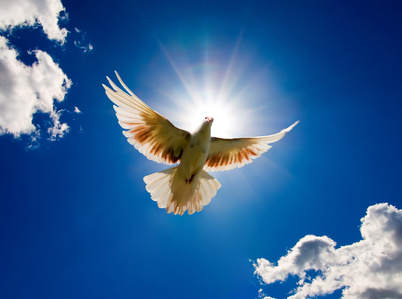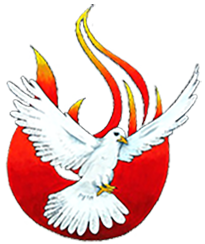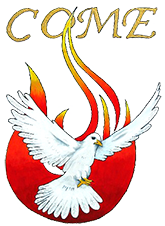Symbols of the Holy Spirit
Symbols of the Holy Spirit help us to see and experience His presence in our lives. Since the Holy Spirit is not a physical being, as Jesus was, it is necessary to look for him in other ways.
The “Dove” is one of the most common symbols used to depict the Holy Spirit — as shown in this image. However, there are seven additional symbols that describe the presence and actions of the Holy Spirit.

How do we Experience the Holy Spirit
The description of each of these symbols is presented below, from the Catechism of the Catholic Church (CCC, 2000).
“The symbolism of water signifies the Holy Spirit’s action in Baptism, since after the invocation of the Holy Spirit it becomes the efficacious sacramental sign of new birth: just as the gestation of our first birth took place in water, so the water of Baptism truly signifies that our birth into the divine life is given to us in the Holy Spirit. As “by one Spirit we were all baptized,” so we are also “made to drink of one Spirit.” Thus the Spirit is also personally the living water welling up from Christ crucified as its source and welling up in us to eternal life.”
— Catechism of the Catholic Church (CCC), 2000, para. 694
“The book of Revelation of St. John, read in the Church’s liturgy, first reveals to us, “A throne stood in heaven, with one seated on the throne”: “the Lord God.” It then shows the Lamb, “standing, as though it had been slain”: Christ crucified and risen, the one high priest of the true sanctuary, the same one “who offers and is offered, who gives and is given.” Finally it presents “the river of the water of life . . . flowing from the throne of God and of the Lamb,” one of most beautiful symbols of the Holy Spirit.”
CCC, 2000, para. 1137
“The Holy Spirit is the living water “welling up to eternal life” in the heart that prays. It is he who teaches us to accept it at its source: Christ. Indeed in the Christian life there are several wellsprings where Christ awaits us to enable us to drink of the Holy Spirit.”
CCC, 2000, para. 2652
The symbolism of anointing with oil also signifies the Holy Spirit, to the point of becoming a synonym for the Holy Spirit. In Christian initiation, anointing is the sacramental sign of Confirmation, called “chrismation” in the Churches of the East. Its full force can be grasped only in relation to the primary anointing accomplished by the Holy Spirit, that of Jesus. Christ (in Hebrew “messiah”) means the one “anointed” by God’s Spirit. There were several anointed ones of the Lord in the Old Covenant, pre-eminently King David. But Jesus is God’s Anointed in a unique way: the humanity the Son assumed was entirely anointed by the Holy Spirit. The Holy Spirit established him as “Christ.” The Virgin Mary conceived Christ by the Holy Spirit who, through the angel, proclaimed him the Christ at his birth, and prompted Simeon to come to the temple to see the Christ of the Lord. The Spirit filled Christ and the power of the Spirit went out from him in his acts of healing and of saving. Finally, it was the Spirit who raised Jesus from the dead. Now, fully established as “Christ” in his humanity victorious over death, Jesus pours out the Holy Spirit abundantly until “the saints” constitute — in their union with the humanity of the Son of God — that perfect man “to the measure of the stature of the fullness of Christ”: “the whole Christ,” in St. Augustine’s expression.
— Catechism of the Catholic Church (CCC), 2000, para. 695
While water signifies birth and the fruitfulness of life given in the Holy Spirit, fire symbolizes the transforming energy of the Holy Spirit’s actions. The prayer of the prophet Elijah, who “arose like fire” and whose “word burned like a torch,” brought down fire from heaven on the sacrifice on Mount Carmel. This event was a “figure” of the fire of the Holy Spirit, who transforms what he touches. John the Baptist, who goes “before (the Lord) in the spirit and power of Elijah,” proclaims Christ as the one who “will baptize you with the Holy Spirit and with fire.” Jesus will say of the Spirit: “I came to cast fire upon the earth; and would that it were already kindled!” In the form of tongues “as of fire,” the Holy Spirit rests on the disciples on the morning of Pentecost and fills them with himself. The spiritual tradition has retained this symbolism of fire as one of the most expressive images of the Holy Spirit’s actions. “Do not quench the Spirit.”
— Catechism of the Catholic Church (CCC), 2000, para. 696
“For a moment Jesus discloses his divine glory, confirming Peter’s confession. He also reveals that he will have to go by the way of the cross at Jerusalem in order to “enter into his glory”. Moses and Elijah had seen God’s glory on the Mountain; the Law and the Prophets had announced the Messiah’s sufferings. Christ’s Passion is the will of the Father: the Son acts as God’s servant; The cloud indicates the presence of the Holy Spirit. “The whole Trinity appeared: the Father in the voice; the Son in the man; the Spirit in the shining cloud.”
— Catechism of the Catholic Church (CCC), 2000, para. 555a
“These two images occur together in the manifestations of the Holy Spirit. In the theophanies of the Old Testament, the cloud, now obscure, now luminous, reveals the living and saving God, while veiling the transcendence of his glory — with Moses on Mount Sinai, at the tent of meeting, and during the wandering in the desert, and with Solomon at the dedication of the Temple. In the Holy Spirit, Christ fulfills these figures. The Spirit comes upon the Virgin Mary and “overshadows” her, so that she might conceive and give birth to Jesus. On the mountain of Transfiguration, the Spirit in the “cloud came and overshadowed” Jesus, Moses and Elijah, Peter, James and John, and “a voice came out of the cloud, saying, ‘This is my Son, my Chosen; listen to him!’” Finally, the cloud took Jesus out of the sight of the disciples on the day of his ascension and will reveal him as Son of man in glory on the day of his final coming.”
— CCC, 2000, para. 697
The seal is a symbol close to that of anointing. “The Father has set his seal” on Christ and also seals us in him. Because this seal indicates the indelible effect of the anointing with the Holy Spirit in the sacraments of Baptism, Confirmation, and Holy Orders, the image of the seal (sphragis) has been used in some theological traditions to express the indelible “character” imprinted by these three unrepeatable sacraments.
— Catechism of the Catholic Church (CCC), 1997, para. 698
Anointing with oil has all these meanings in the sacramental life: the pre-baptismal anointing with the oil of catechumens signifies cleansing and strengthening; the anointing of the sick expresses healing and comfort; the post-baptismal anointing with sacred chrism in Confirmation and ordination is the sign of consecration. By Confirmation Christians, that is, those who are anointed, share more completely in the mission of Jesus Christ and the fullness of the Holy Spirit with which he is filled, so that their lives may give off “the aroma of Christ.”
— CCC, 2000, para. 1294
By this anointing the confirmand receives the “mark,” the seal of the Holy Spirit. A seal is a symbol of a person, a sign of personal authority, or ownership of an oblect. Hence soldiers were marked with their leader’s seal and slaves with their master’s. A seal authenticates a juridical act or document and occasionally makes it secret.
— CCC, 2000, para. 1295
Jesus heals the sick and blesses little children by laying hands on them. In his name the apostles will do the same. Even more pointedly, it is by the Apostles’ imposition of hands that the Holy Spirit is given. The Letter to the Hebrews lists the imposition of hands among the “fundamental elements” of its teaching. The Church has kept this sign of the all-powerful outpouring of the Holy Spirit in its sacramental epicleses.
— Catechism of the Catholic Church (CCC), 2000, para. 699
It is by the finger of God that [Jesus] cast out demons.” If God’s law was written on tablets of stone “by the finger of God,” then the “letter from Christ” entrusted to the care of the apostles, is written “with the Spirit of the living God, not on tablets of stone, but on tablets of human hearts.” The hymn Veni Creator Spiritus invokes the Holy Spirit as the “finger of the Father’s right hand.”
— Catechism of the Catholic Church (CCC), 2000, para. 700
“Jesus’ public life begins with his baptism by John in the Jordan. John preaches “a baptism of repentance for the forgiveness of sins”. A crowd of sinners – tax collectors and soldiers, Pharisees and Sadducees, and prostitutes – come to be baptized by him. “Then Jesus appears.” The Baptist hesitates, but Jesus insists and receives baptism. Then the Holy Spirit, in the form of a dove, comes upon Jesus and a voice from heaven proclaims, “This is my beloved Son.” This is the manifestation (“Epiphany”) of Jesus as Messiah of Israel and Son of God.”
— Catechism of the Catholic Church (CCC), 2000, para. 535
“At the end of the flood, whose symbolism refers to Baptism, a dove released by Noah returns with a fresh olive-tree branch in its beak as a sign that the earth was again habitable. When Christ comes up from the water of his baptism, the Holy Spirit, in the form of a dove, comes down upon him and remains with him. The Spirit comes down and remains in the purified hearts of the baptized. In certain churches, the Eucharist is reserved in a metal receptacle in the form of a dove (columbarium) suspended above the altar. Christian iconography traditionally uses a dove to suggest the Spirit.”
— CCC, 2000, para. 701
In art the Holy Spirit is often depicted as a dove. This is probably because in the New Testament we first meet the Holy Spirit at the baptism of Jesus. Some of the passages that depict the Holy Spirit as a dove include the following:
. . . and he saw the Spirit of God descending like a dove [and] coming upon him. (Matthew 3:16)
. . . and the Spirit, like a dove, descending upon him. (Mark 1:10)
. . . and the holy Spirit descended upon him in bodily form like a dove. (Luke 3:22)
— Loyola Press
These eight symbols help us to recognize the presence of the Holy Spirit in Holy Scripture and in our lives.


